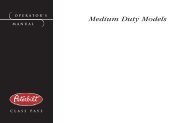Regional Haul Model Operator's Manual - Peterbilt Motors Company
Regional Haul Model Operator's Manual - Peterbilt Motors Company
Regional Haul Model Operator's Manual - Peterbilt Motors Company
You also want an ePaper? Increase the reach of your titles
YUMPU automatically turns print PDFs into web optimized ePapers that Google loves.
PREVENTIVE MAINTENANCE<br />
Tire Inflation<br />
Most tire wear problems are caused by underinflation as<br />
the result of slow leaks. So you will want to check tire<br />
pressure regularly. Give the tires a visual test every day,<br />
and check inflation with a gauge every week.<br />
When checking tire pressure, inspect each tire for damage<br />
to sidewalls, cuts, cracks, uneven wear, rocks<br />
between dual wheels (tires), etc. If a tire appears underinflated,<br />
check for damage to the wheel assembly. Do not<br />
forget to check between dual wheels. If you find wheel<br />
damage, have an expert tire service repair it.<br />
WARNING! Do not repair damaged tires<br />
unless you are fully qualified and equipped to<br />
do so. Wheel and tire assemblies cannot be<br />
worked on without proper tools and equipment,<br />
such as: safety cages or restraining<br />
devices. Have all tire repairs performed by an<br />
expert. And stand away from the tire assembly<br />
while the expert is working. Failure to do<br />
this may result in death or injury.<br />
TIRES AND WHEELS<br />
CAUTION: Pressure should be checked when<br />
the tires are cool. Warm or hot tires cause<br />
pressure buildup and will give you an inaccurate<br />
reading. So never deflate a warm tire to<br />
the specified pressure.<br />
Underinflated tires will adversely affect the operation of<br />
the vehicle and tires:<br />
• making steering difficult<br />
• causing extra strain on the tire sidewalls<br />
• reducing the tread life of tires due to the high temperatures<br />
generated from excess flexing of the tire<br />
• Inflate tires to the manufacturer's cold air pressure<br />
specification molded into the tire side wall.<br />
Lower tire pressure does not give you more traction on ice<br />
or snow. Underinflation actually reduces traction and<br />
steering control. See the tire manufacturer's Drivers<br />
Handbook for more information on proper operation and<br />
use of tires.<br />
<strong>Regional</strong> <strong>Haul</strong> (R05/10) Y53-6033 – 201 –
















